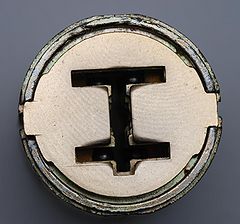Fichet 480: Difference between revisions
mNo edit summary |
TecknicalTom (talk | contribs) (adding pages to the "Lock models" category) |
||
| Line 77: | Line 77: | ||
[[Category:Fichet|480]] | [[Category:Fichet|480]] | ||
[[Category:Wafer locks]] | [[Category:Wafer locks]] | ||
[[Category:Lock models]] | |||
Revision as of 13:16, 1 October 2010
Fichet 480
| Fichet 480 | |
 | |
| Name | Fichet 480 |
|---|---|
| Manufacturer | Fichet |
| Lock Type | Cylinder |
| Lock Design | Wafer |
| Year(s) Produced | 1949 - 19?? |
| Patent | US 4,044,578 US 4,296,618 |
| Related Locks | |
| Fichet 787 | |
The 480 (or 450, 481, 482, 483, 484) is a wafer lock made by Fichet. It uses ten wafers and two sidebars as locking components. While technically a normal wafer lock, the 480 uses an interesting design that improves security and longevity of both the key and lock. The 480 is easily identified because of the H shaped keyway. The various models of this lock can be identified by the style of key bow and minor differences in the design and placement of internal components.
The 480 was originally thought to be a strong lock, but it is no longer produced because of a design vulnerability that allowed the cylinder to be forcibly opened using a hardened blank key.
The 480 has since been superseded by the Fichet 787.
Principles of operation
|
|
Fichet/locksmith literature may also refer to wafers as "rockers" due to the way they work. Lockwiki uses the traditional terms to avoid confusion. |
The 480 uses a rather unique wafer design with 10 wafers and two sidebars. Five wafers and one sidebar are located on each side of the lock in the 3 and 9 o'clock positions.
Each wafer is held in place by a retaining rod that extends through the plug. When the key is inserted, the wafers rotate around the rod and interface with the sidebars. The wafers sit on top of a capped spring which pushes them into their default position. A ball bearing is placed below the wafer, in the keyway, to interface with the key itself. The key never directly touches the wafers, instead it uses the ball bearing to move them. This reduces wear and makes use of the key smoother.
The key itself has a H shaped profile and four active bitting surfaces. The key is not symmetrical and may only be inserted in one orientation.
Manipulation resistance is provided in the form of false gates on the wafers.
Sidebars used in the 450.
Disassembly instructions
The 480 is relatively easy to diassemble, but it has many small parts that might cause problems. Remember to maintain the order of components as they are removed from each side of the lock. Components must be returned to the correct side when the lock is reassembled for proper function.
- Remove the cam or C-clip and withdraw the plug.
- Remove the sidebars and sidebar springs.
- With a flathead screwdriver, remove the plug faceplate.
- Place the plug in a vise with one set of wafers facing up. With a hammer and a small flathead screwdriver, lightly tap (from the back of the plug) the retaining rod out. When the retaining rod is removed the wafers, springs, caps, and ball bearings can all be removed. Be careful to remove the rod only when the wafers are facing up, otherwise all the components will spill out.
- Repeat for second set of wafers.
Vulnerabilities
The 480 may be vulnerable to one or more of the following:
- Lockpicking (A special tool is available for picking the 480, though traditional tools may also be used.)[1]
- Impressioning
- Decoding
- Destructive entry (A blank key made of a hardened material can be used to forcibly rotate and unlock the 480.)[2]
Gallery
References
- ↑ Cylindre Fichet 480-484 (French)
- ↑ Holzmanm, Noah. Fichet 480.







